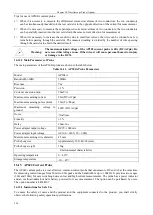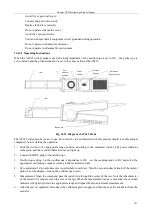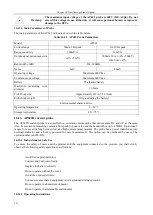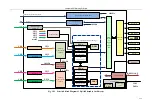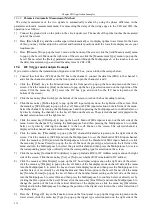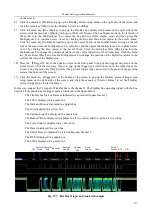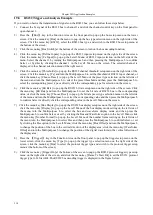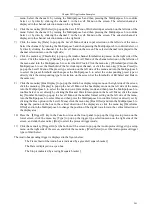
Chapter XIX Application Examples
232
19.3.2
Parameter Automatic Measurement Method
The delay measurement of the two signals is automatically realized by using the phase difference in the
parameter automatic measurement menu. For measuring the delay of the rising edges in the CH1 and CH2, the
operation is as follows:
1)
Connect the ground wire on the probe to the circuit under test. The needle of the probe touches the measured
point of the circuit.
2)
Press
【
AutoSet
】
key and the oscilloscope will automatically set to display optimal waveforms. On the basis
of this, you may further adjust the vertical and horizontal positions until the waveform display meets your
requirements.
3)
Press
【
Measure
】
to pop up the level 1 menu at the bottom of the screen, click the [Add Measurement] menu
to pop up the Level2 Menu on the right side of the screen, click the [Measurement Type] menu to pop up the
Level3 Menu, select the [Delay] parameter measurement through the Multipurpose b or the touch screen, set
the delay measurement type, and read the delay time of CH1-CH2.
19.4
I2C Trigger and Analysis Example
If you want to observe the transmission of signals on the I2C bus, you can follow these steps below:
1)
Connect the clock line (SCLK) of the I2C bus to the channel 1, connect the data line (SDA) to the channel 2,
and click the channel control key on the front panel to open the channels 1 and 2;
2)
Click the
【
Bus
】
key in the Function Area on the front panel to pop up the bus setup menu on the lower
screen. Click the menu key [Bus] on the menu to pop up the bus type selection menu on the right side of the
screen. Click the menu key [I2C], select the I2C bus type, and switch to the I2C bus setup menu at the
bottom of the screen;
3)
Click the menu key [Bus Switch] at the bottom of the screen to turn on the bus decoding function;
4)
Click the menu key [Define Inputs] to pop up the I2C input setup menu on the right side of the screen. Click
the menu key [SCLK Input] to pop up the Level3 Menu of SCLK input selection on the left side of the menu.
Select the channel 1 by turning the Multipurpose b and then pressing the Multipurpose b to confirm Select, or
by directly clicking the channel 1 in the Level3 Menu on the screen. The selected channel is displayed in the
channel selection menu of the right menu;
5)
Click the menu key [SDA Input] to pop up the Level3 Menu of SDA input selection on the left side of the
menu. Select the channel 2 by turning the Multipurpose b and then pressing the Multipurpose b to confirm
Select, or by directly clicking the channel 2 in the Level3 Menu on the screen. The selected channel is
displayed in the channel selection menu of the right menu;
6)
Click the menu key [Thresholds] to pop up the I2C channel threshold setup menu on the right side of the
screen. Click the menu key [SCLK] and turn the Multipurpose b to set the threshold of SCLK input channel.
Click the menu key [SDA] and turn the Multipurpose b to set the threshold of SDA input channel, or click
the menu key [Choose Preset] to pop up the Level3 Menu of the preset type selection on the left side of the
menu and turn the Multipurpose b to select the preset threshold and then press the Multipurpose b to select
the corresponding preset type or directly click the corresponding type for selection on the screen;
7)
Click the menu key [Include R/W in Address] to pop up Include R/W in I2C Address setup menu on the right
side of the screen. Click the menu key [Yes] or [No] to set whether R/W is included in I2C address;
8)
Click the menu key [Bus Display] to pop up the I2C bus display setup menu on the right side of the screen,
click the menu key [Display] to pop up the Level3 Menu of the bus display mode on the left side of the menu,
turn the Multipurpose b to select the bus and waveform display mode and then press the Multipurpose b to
confirm Select, or set directly by clicking the Bus and Waveforms option in the Level3 Menu; click the menu
key [Number Format] to pop up the Level3 Menu of the number format setting on the left side of the menu,
turn the Multipurpose b to select Hex and then press the Multipurpose b to confirm Select, or directly set by
clicking the Hex option in the Level3 Menu; click the menu key [Bus Offset] and turn the Multipurpose b to
change the position of the bus in the vertical direction of the display area; click the menu key [Waveforms
Offset] and turn the Multipurpose b to change the position of the digital waveform in the vertical direction of
the display area;
9)
Press the
【
Trigger
】
key in the Function Area on the front panel to pop up the trigger setup menu on the
lower screen, click the menu key [Type] to pop up the trigger type selection menu on the right side of the
Summary of Contents for 4456 Series
Page 10: ...VIII...
Page 55: ...Chapter V Trigger System 45 Fig 5 51 RF Test Signal Example...
Page 69: ...Chapter VII Mathematical Operation 59 Fig 7 10 Advanced Math Example...
Page 71: ...Chapter VIII Display System 61 Fig 8 3 Wfm Palette Menu Fig 8 4 Normal Palette...
Page 72: ...Chapter VIII Display System 62 Fig 8 5 Inverted Palette Fig 8 6 Temperature Palette...
Page 75: ...Chapter VIII Display System 65 Fig 8 12 XY Display Example...
Page 165: ...Chapter XI Protocol Analyzer Option 155 Fig 11 242 1553 Trigger and Analysis Example...



